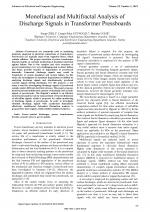| 2/2018 - 9 |
Monofractal and Multifractal Analysis of Discharge Signals in Transformer PressboardsCEKLI, S. |
| Extra paper information in |
| Click to see author's profile in |
| Download PDF |
Author keywords
partial discharges, power transformers, fractals, acoustic sensors, power quality
References keywords
board(12), insulation(10), fractal(9), discharge(9), analysis(7), voltage(6), partial(6), higuchi(5), high(5), electric(5)
Blue keywords are present in both the references section and the paper title.
About this article
Date of Publication: 2018-05-31
Volume 18, Issue 2, Year 2018, On page(s): 69 - 76
ISSN: 1582-7445, e-ISSN: 1844-7600
Digital Object Identifier: 10.4316/AECE.2018.02009
Web of Science Accession Number: 000434245000009
SCOPUS ID: 85047883421
Abstract
Pressboards are commonly used as insulating materials employed in electrical connections of transformers. Pressboards are typically made from vegetable fibers, which contain cellulose. The proper operation of power transformer depends mainly on constant monitoring of insulation materials against failure. Due to the complex and close structure of power transformers, it is very challenging task to detect failure and hence possible location of degradation of pressboard internally. Generated discharge signals may result in breakdown of system insulation and system failure. In this study, the investigation of insulation degradation is fulfilled by analyzing discharge signals and simultaneously produced acoustic signals during discharges. For this purpose, a test setup is used for investigating discharge signals of pressboard samples under different electrical stresses. This paper proposes monofractal and multifractal analysis of discharge and acoustic signals of pressboards. The Higuchi's method is an effective monofractal analysis tool for measurement of fractal dimension of self-affine signals, which is proposed for online monitoring of discharge signals of pressboards. In order to investigate obtained discharge signals with accelerated fluctuations effectively, multifractal detrended fluctuation analysis is proposed for these signals, which exhibit nonlinear behavior. |
| References | | | Cited By |
Web of Science® Times Cited: 2 [View]
View record in Web of Science® [View]
View Related Records® [View]
Updated 2 weeks, 5 days ago
SCOPUS® Times Cited: 2
View record in SCOPUS® [Free preview]
View citations in SCOPUS® [Free preview]
[1] Anomaly Detection in IoT Communication Network Based on Spectral Analysis and Hurst Exponent, Dymora, Paweł, Mazurek, Mirosław, Applied Sciences, ISSN 2076-3417, Issue 24, Volume 9, 2019.
Digital Object Identifier: 10.3390/app9245319 [CrossRef]
[2] Statistical analysis of induced magnetic fields on oil-impregnated insulation pressboards, Atalar, Fatih, Uzunoğlu, Cengiz Polat, Cekli, Serap, Uğur, Mukden, Electrical Engineering, ISSN 0948-7921, Issue 4, Volume 102, 2020.
Digital Object Identifier: 10.1007/s00202-020-01012-8 [CrossRef]
Disclaimer: All information displayed above was retrieved by using remote connections to respective databases. For the best user experience, we update all data by using background processes, and use caches in order to reduce the load on the servers we retrieve the information from. As we have no control on the availability of the database servers and sometimes the Internet connectivity may be affected, we do not guarantee the information is correct or complete. For the most accurate data, please always consult the database sites directly. Some external links require authentication or an institutional subscription.
Web of Science® is a registered trademark of Clarivate Analytics, Scopus® is a registered trademark of Elsevier B.V., other product names, company names, brand names, trademarks and logos are the property of their respective owners.
Faculty of Electrical Engineering and Computer Science
Stefan cel Mare University of Suceava, Romania
All rights reserved: Advances in Electrical and Computer Engineering is a registered trademark of the Stefan cel Mare University of Suceava. No part of this publication may be reproduced, stored in a retrieval system, photocopied, recorded or archived, without the written permission from the Editor. When authors submit their papers for publication, they agree that the copyright for their article be transferred to the Faculty of Electrical Engineering and Computer Science, Stefan cel Mare University of Suceava, Romania, if and only if the articles are accepted for publication. The copyright covers the exclusive rights to reproduce and distribute the article, including reprints and translations.
Permission for other use: The copyright owner's consent does not extend to copying for general distribution, for promotion, for creating new works, or for resale. Specific written permission must be obtained from the Editor for such copying. Direct linking to files hosted on this website is strictly prohibited.
Disclaimer: Whilst every effort is made by the publishers and editorial board to see that no inaccurate or misleading data, opinions or statements appear in this journal, they wish to make it clear that all information and opinions formulated in the articles, as well as linguistic accuracy, are the sole responsibility of the author.



